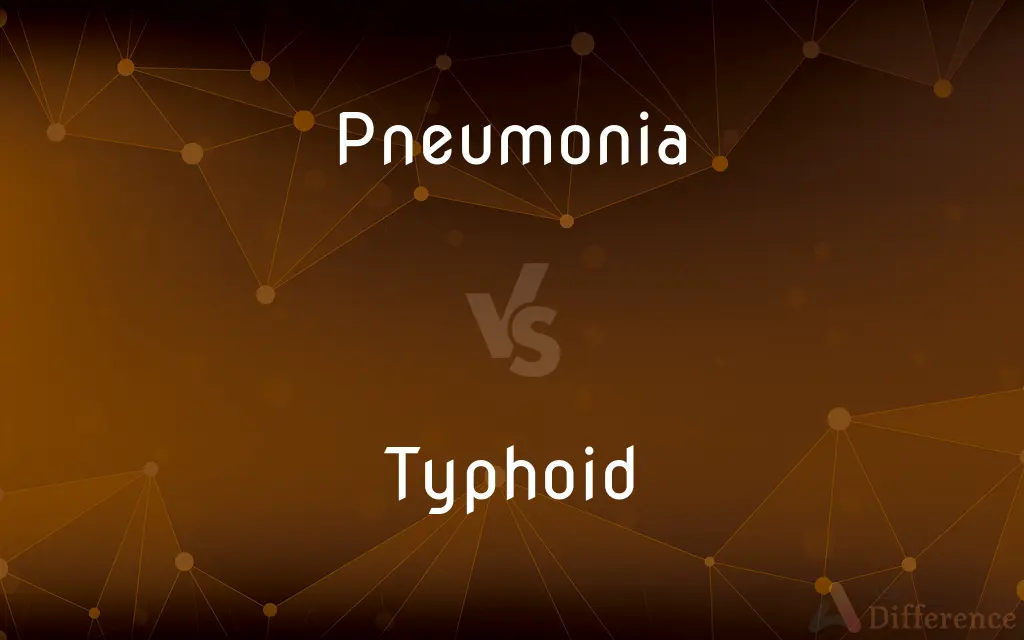Pneumonia vs. Typhoid — What's the Difference?
By Tayyaba Rehman — Published on August 31, 2023
Pneumonia is an inflammatory condition affecting the lungs, while typhoid is a bacterial infection caused by Salmonella Typhi, primarily impacting the intestines.

Difference Between Pneumonia and Typhoid
Table of Contents
ADVERTISEMENT
Key Differences
Pneumonia refers to an inflammatory condition primarily affecting the air sacs in the lungs. It can result from various agents, including bacteria, viruses, and fungi. When these sacs get inflamed, they can fill with fluid or pus, leading to symptoms like coughing, fever, and difficulty breathing. On the other hand, typhoid is a specific bacterial infection.
Typhoid fever is caused by the bacteria Salmonella Typhi. This disease is transmitted primarily through contaminated food and water. Once ingested, the bacteria quickly multiply and spread into the bloodstream, affecting various organs, especially the intestines. Symptoms may include high fever, headache, and abdominal pain.
While both pneumonia and typhoid may present with fever, their primary affected areas and causes differ significantly. Pneumonia predominantly impacts the respiratory system, whereas typhoid chiefly affects the digestive system. Diagnosis and treatment for each are distinct.
Vaccinations are available for both diseases. Pneumonia vaccines primarily target bacterial causes, especially in children and the elderly. Typhoid vaccines are vital for those traveling to areas where the disease is prevalent. Prevention, including good hygiene practices, remains essential for both.
Pneumonia and typhoid are both severe health conditions, but they have distinct causes, symptoms, and affected areas. Pneumonia is respiratory in nature, whereas typhoid is an enteric disease primarily impacting the digestive system.
ADVERTISEMENT
Comparison Chart
Affected System
Respiratory system (lungs)
Digestive system (intestines)
Causative Agent
Bacteria, viruses, fungi
Salmonella Typhi bacteria
Transmission
Airborne droplets
Contaminated food and water
Main Symptoms
Cough, fever, chest pain, difficulty breathing
High fever, headache, abdominal pain
Preventative Measure
Vaccination, avoiding infected individuals
Vaccination, safe drinking water, and food hygiene
Compare with Definitions
Pneumonia
An inflammation of the lung tissue.
She was hospitalized due to severe pneumonia.
Typhoid
A fever resulting from a specific bacterial strain.
Poor sanitation can lead to outbreaks of typhoid.
Pneumonia
A condition where lung air sacs fill with fluid or pus.
Difficulty breathing is a common symptom of pneumonia.
Typhoid
An enteric fever impacting the intestines.
He contracted typhoid after consuming contaminated water.
Pneumonia
A respiratory disease caused by various agents.
Viral pneumonia is less severe than its bacterial counterpart.
Typhoid
Typhoid fever.
Pneumonia
A potentially life-threatening lung infection.
Infants and the elderly are most susceptible to pneumonia.
Typhoid
A disease transmitted through contaminated food or water.
The city took measures to prevent the spread of typhoid.
Pneumonia
Pneumonia is an inflammatory condition of the lung primarily affecting the small air sacs known as alveoli. Symptoms typically include some combination of productive or dry cough, chest pain, fever and difficulty breathing.
Typhoid
Of, relating to, or resembling typhoid fever.
Pneumonia
An acute or chronic disease marked by inflammation of the lungs, usually caused by a bacterium, virus, or other infectious agent.
Typhoid
Characterised by or relating to typhus.
Pneumonia
Inflammation of the lungs.
Typhoid
Of or pertaining to typhus; resembling typhus; of a low grade like typhus; as, typhoid symptoms.
Pneumonia
A disease often characterized by fever and cough.
He was prescribed antibiotics to treat pneumonia.
Typhoid
A condition known for its prolonged high fever.
The patient's typhoid symptoms persisted for over a week.
Pneumonia
An acute or chronic inflammation of the lungs caused by viruses, bacteria or other microorganisms, or sometimes by physical or chemical irritants.
Typhoid
Serious infection marked by intestinal inflammation and ulceration; caused by Salmonella typhosa ingested with food or water
Pneumonia
Lung inflammation caused by bacterial or viral infection, in which the air sacs fill with pus and may become solid. Inflammation may affect both lungs (double pneumonia) or only one (single pneumonia).
Typhoid
A bacterial infection caused by Salmonella Typhi.
Travelers to certain regions are advised to get a typhoid vaccine.
Pneumonia
Respiratory disease characterized by inflammation of the lung parenchyma (excluding the bronchi) with congestion caused by viruses or bacteria or irritants
Common Curiosities
Can both diseases be treated with antibiotics?
Pneumonia caused by bacteria can be treated with antibiotics, as can typhoid.
How is typhoid transmitted?
Typhoid is primarily transmitted through contaminated food and water.
Is pneumonia contagious?
Some forms of pneumonia, especially those caused by bacteria and viruses, can be contagious.
What is the primary symptom of typhoid?
High fever, often accompanied by headache and abdominal pain.
Can pneumonia be prevented?
Yes, through vaccination and by avoiding contact with infected individuals.
What causes pneumonia?
Pneumonia can be caused by bacteria, viruses, or fungi.
Is there a vaccine for typhoid?
Yes, there are vaccines available for typhoid, especially recommended for travelers.
Share Your Discovery

Previous Comparison
Mentally vs. Physically
Next Comparison
Material vs. ResourceAuthor Spotlight
Written by
Tayyaba RehmanTayyaba Rehman is a distinguished writer, currently serving as a primary contributor to askdifference.com. As a researcher in semantics and etymology, Tayyaba's passion for the complexity of languages and their distinctions has found a perfect home on the platform. Tayyaba delves into the intricacies of language, distinguishing between commonly confused words and phrases, thereby providing clarity for readers worldwide.














































